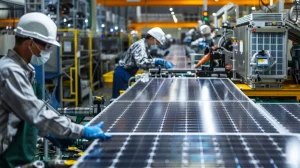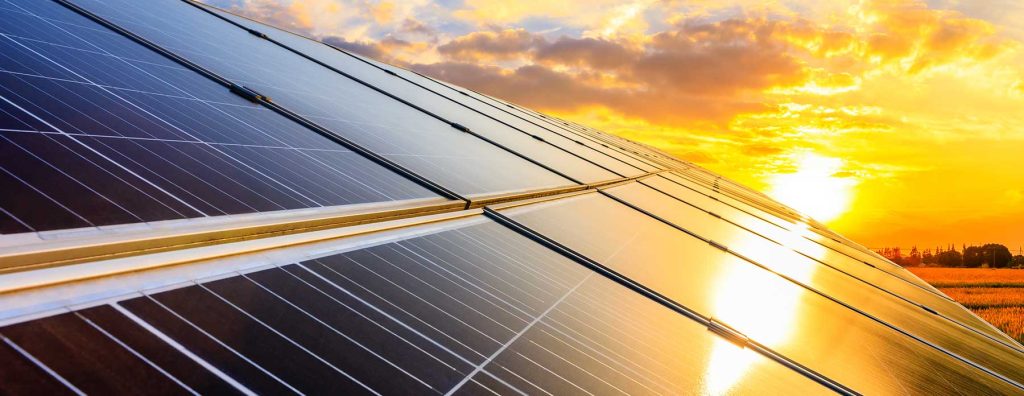Solar energy is rapidly becoming a cornerstone of the global transition to renewable energy sources. As concerns over climate change and energy security grow, solar panels are increasingly recognised as a vital technology for harnessing the power of the sun.
These devices, which convert sunlight into usable electricity, are not just for the environmentally conscious but are also becoming a practical solution for businesses and homeowners alike.
Understanding how solar panels work is crucial for anyone considering this technology as a viable energy source.
This blog aims to provide a detailed explanation of the inner workings of solar panels, shedding light on the scientific principles and technologies that make them so effective.
From the fundamental photovoltaic effect to the various components that make up a solar panel, this guide will cover everything you need to know about how these remarkable devices generate electricity.
By the end, you will have a thorough understanding of the process that turns sunlight into power, helping you make informed decisions about adopting solar energy.
Basic Principles of Solar Energy
Solar energy is derived from the sun’s radiation, a seemingly limitless and clean source of power. The sun emits vast amounts of energy in the form of light and heat, which can be captured and converted into electricity.
At the heart of this process is the photovoltaic (PV) effect, a phenomenon where certain materials generate an electric current when exposed to sunlight. This effect is the fundamental principle behind solar panels and has been known to science for over a century.
Photovoltaic cells, the essential components of solar panels, are designed to exploit this effect. When sunlight strikes these cells, it excites electrons within the material, causing them to move and generate a flow of electric current.
This process is remarkably efficient and sustainable, as it directly converts solar energy into electricity without the need for moving parts or fuel, making it a key technology in the quest for renewable energy solutions.
Components of a Solar Panel
 A solar panel is a sophisticated piece of technology composed of several key components, each playing a crucial role in its operation.
A solar panel is a sophisticated piece of technology composed of several key components, each playing a crucial role in its operation.
The most important of these are the photovoltaic cells, which are typically made from silicon, a semiconductor material known for its excellent electrical properties.
These cells are arranged in a grid pattern on the panel’s surface, where they capture sunlight and convert it into electricity. The efficiency of a solar panel largely depends on the quality and purity of these cells, with monocrystalline silicon cells offering the highest efficiency.
In addition to the PV cells, a solar panel includes several layers of encapsulation that protect the cells from environmental factors such as moisture, dust, and physical damage.
These layers usually consist of a transparent front layer made of tempered glass and a durable polymer back sheet.
The panel is framed in aluminium, providing structural integrity and allowing for easy installation. The junction box and wiring, located at the back of the panel, manage the electrical connections and protect against short circuits and other electrical issues.
How Solar Panels Generate Electricity
The process of electricity generation in solar panels begins when photons, or particles of light, are absorbed by the photovoltaic cells. This absorption energises the electrons within the semiconductor material, causing them to become mobile.
In essence, these excited electrons break free from their atoms, creating what is known as an electron-hole pair. This movement of electrons is the foundation of the electric current generated by the solar panel.
Once the electrons are mobilised, they are driven by an electric field created within the photovoltaic cell, typically by the junction of two different types of silicon (p-type and n-type).
This electric field acts as a diode, allowing electrons to flow in a single direction, thus generating a direct current (DC).
This DC electricity is then collected by the panel’s wiring and is ready to be converted into usable alternating current (AC) by the inverter, which is crucial for powering most household appliances and feeding electricity into the grid.
Conversion of DC to AC

Solar panels generate electricity in the form of direct current (DC), but for this energy to be used in homes or businesses, it needs to be converted into alternating current (AC).
This is where the inverter comes into play, serving as a critical component in any solar power system.
The inverter’s primary function is to convert the DC electricity produced by the solar panels into AC electricity, which is compatible with the electrical systems used in most buildings and by the grid.
There are several types of inverters, each suited to different applications. String inverters are the most common and are used in systems where multiple solar panels are connected in series.
Microinverters, on the other hand, are installed on each individual panel, offering better efficiency and monitoring capabilities, particularly in systems where shading or panel mismatch might occur.
Hybrid inverters are also gaining popularity, combining the functions of a standard inverter with the ability to manage energy storage systems, such as batteries, providing even greater flexibility and energy independence.
Efficiency Factors in Solar Panels
The efficiency of solar panels, or how effectively they convert sunlight into electricity, is influenced by several factors.
The quality of the photovoltaic cells themselves is a major determinant, with monocrystalline silicon cells generally offering the highest efficiency rates due to their high purity and uniform structure.
However, efficiency is not solely dependent on the cells; environmental factors also play a significant role. For instance, solar panels are less efficient at higher temperatures, so proper ventilation and cooling mechanisms are important in their installation.
Another crucial factor is the orientation and tilt of the panels. To maximise efficiency, solar panels must be positioned to capture the most sunlight possible throughout the day, typically facing them south in the UK and adjusting their angle according to the latitude.
Shading from nearby objects such as trees or buildings can also significantly reduce efficiency, as even partial shading can disrupt the energy production of an entire panel string.
Regular maintenance, including cleaning to remove dirt and debris, is essential to ensure that panels operate at their maximum potential.
Types of Solar Panels
There are several types of solar panels available, each with its own set of advantages and drawbacks.
Monocrystalline solar panels are made from single-crystal silicon and are known for their high efficiency and longevity. These panels are easily recognisable by their uniform dark colour and rounded edges.
They are particularly suited for installations where space is limited, as they generate more power per square metre than other types of panels.
Polycrystalline solar panels, made from multiple silicon crystals, are a more cost-effective option.
While they tend to be less efficient than monocrystalline panels, they are still a popular choice for many residential and commercial installations due to their lower price point.
Thin-film solar panels, which use layers of semiconductor materials other than silicon, are another alternative.
These panels are less efficient but are lightweight and flexible, making them ideal for specific applications such as portable solar devices or installations on irregular surfaces.
Applications of Solar Panels
Solar panels have a wide range of applications, making them a versatile solution for energy generation. In residential settings, they are most commonly installed on rooftops, providing households with a reliable source of renewable energy that can significantly reduce electricity bills.
In off-grid scenarios, such as in remote areas, solar panels can be paired with battery storage to provide a self-sufficient energy system, ensuring power availability even when the sun isn’t shining.
Commercial and industrial uses of solar panels are also on the rise, with large-scale installations becoming increasingly common.
These setups, often referred to as solar farms, can cover vast areas and generate significant amounts of electricity, contributing to the energy needs of businesses, factories, and even entire communities.
Additionally, portable solar panels are gaining popularity, particularly in industries like construction, where they are used to power equipment and tools in remote locations.
These panels are also invaluable in disaster relief efforts, providing a quick and deployable source of power in emergencies.
Environmental and Economic Benefits
The environmental benefits of solar panels are one of their most compelling attributes. By generating electricity from sunlight, solar panels produce no greenhouse gas emissions during operation, significantly reducing the carbon footprint of those who use them.
This makes them an essential tool in the fight against climate change, as they help to decrease reliance on fossil fuels, which are the primary source of carbon emissions globally.
From an economic perspective, solar panels offer substantial long-term savings. While the initial investment can be considerable, the reduction in energy bills over time often leads to a full return on investment within a few years.
Additionally, many governments offer incentives and subsidies to encourage the adoption of solar energy, further reducing the cost.
Moreover, with energy prices rising, the ability to generate your electricity provides a buffer against market fluctuations, offering both financial security and energy independence.
Solar panels represent a powerful and sustainable solution for harnessing the sun’s energy.
By understanding the detailed mechanics of how solar panels work—from the photovoltaic effect to the various factors that influence efficiency—you can make informed decisions about adopting this technology.
Whether for residential, commercial, or industrial use, solar panels offer significant environmental and economic benefits, contributing to a cleaner, more sustainable future.





